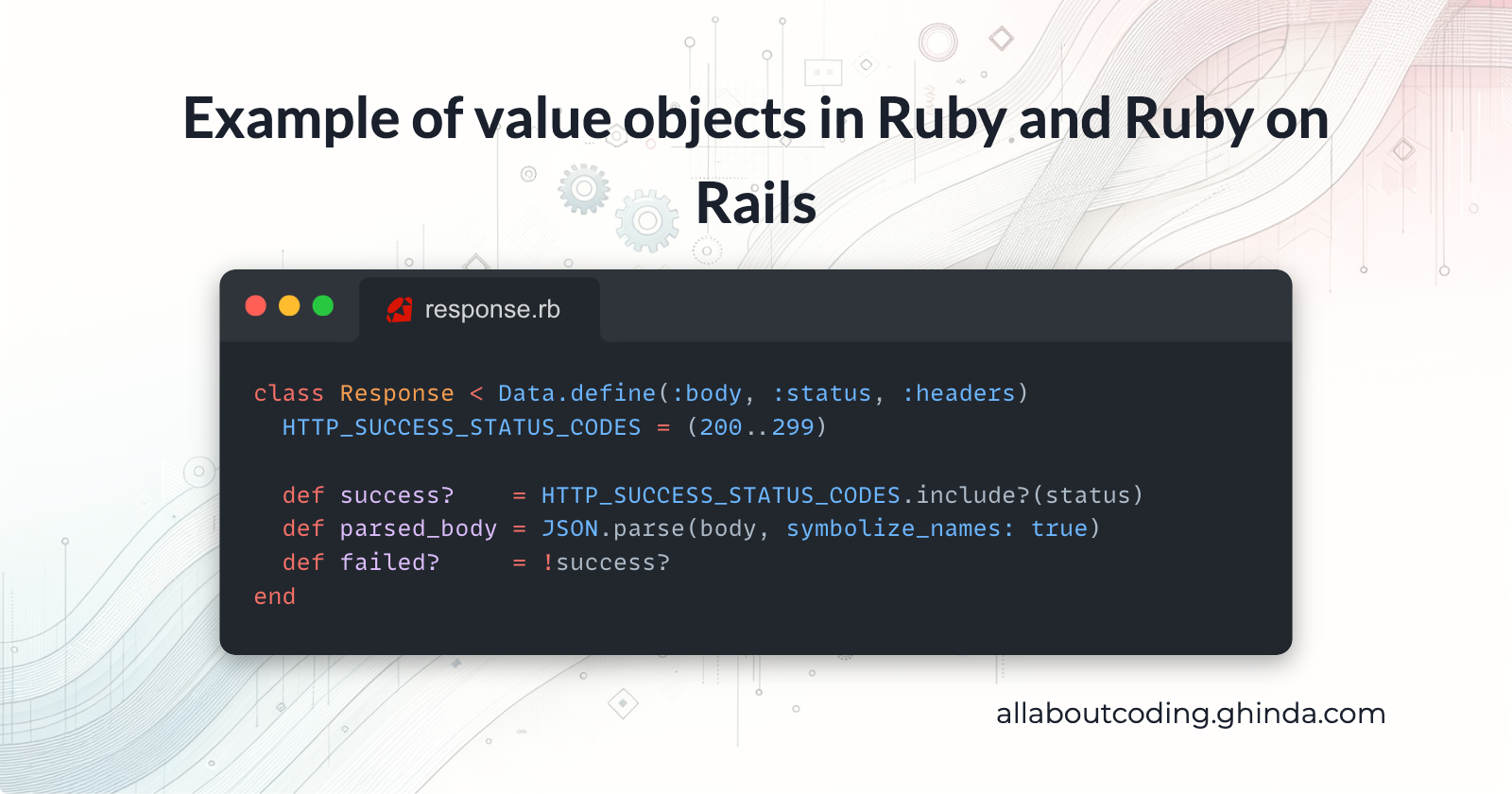Example of value objects using Ruby's Data class
 Lucian Ghinda
Lucian Ghinda
Last week, I wrote an article about how to create value objects in Ruby - the idiomatic way. This week, I will share some real examples of using the data object to show some real examples.
Remove boilerplate constructor code
If you are defining classes and expose the initializer parameters as getters and you plan to make them immutable, then I think you just found the most common case for using the Data class:
Instead of this:
class Link
attr_reader :url, :source
def initialize(url:, source:)
@url = url
@source = source
end
end
I write this:
class Link < Data.define(:url, :source)
end
You can of course also write the simple form, but I do recommend the the previous way with inheritance (will followup in another article about this):
Link = Data.define(:url, :source)
When calling an external API
When calling an external API that returns JSON, I like to implement a method that returns a Response object.
Here I define a Response object with two computed properties:
parsed_body
success
class Response < Data.define(:body, :status, :headers)
HTTP_SUCCESS_STATUS_CODES = (200..299)
def success? = HTTP_SUCCESS_STATUS_CODES.include?(status)
def parsed_body = JSON.parse(body, symbolize_names: true)
def failed? = !success?
end
Mind you that you cannot memoize using instance variables inside a Data class due to immutability. If you try something like this you will get FrozenError
class Response < Data.define(:body, :status, :headers)
def parsed_body
@parsed_body ||= JSON.parse(body, symbolize_names: true)
end
end
r = Response.new(body: "{}", status: 200, headers: {})
r.parsed_body
# can't modify frozen Response: #<data Response body="{}", status=200, headers={}> (FrozenError)
A more full example might look like this using httparty gem
require 'httparty'
require 'json'
class Response < Data.define(:body, :status, :headers)
HTTP_SUCCESS_STATUS_CODES = (200..299)
def success? = HTTP_SUCCESS_STATUS_CODES.include?(status)
def parsed_body = JSON.parse(body, symbolize_names: true)
def failed? = !success?
end
def get(url, query: {})
response = HTTParty.get(url, query)
Response.new(body: response.body, status: response.code, headers: response.headers)
end
response = get(
'https://bsky.social/xrpc/' \
'com.atproto.identity.resolveHandle?handle=lucianghinda.com')
puts response.parsed_body[:did] # did:plc:1362asasdah213212
puts response.success? # true
From this example you can for example expand it to add a RateLimit object:
require 'httparty'
require 'json'
class RateLimit < Data.define(:limit, :remaining, :reset)
end
class Response < Data.define(:body, :status, :headers, :rate_limit)
HTTP_SUCCESS_STATUS_CODES = (200..299)
def success? = HTTP_SUCCESS_STATUS_CODES.include?(status)
def parsed_body = JSON.parse(body, symbolize_names: true)
def failed? = !success?
end
def get(url, query: {})
response = HTTParty.get(url, query)
rate_limit = RateLimit.new(
limit: response.headers['ratelimit-limit'].to_i,
remaining: response.headers['ratelimit-remaining'].to_i,
reset: response.headers['ratelimit-reset'].to_i
)
Response.new(
body: response.body,
status: response.code,
headers: response.headers,
rate_limit: rate_limit
)
end
You can even add a constructor to RateLimit for example:
class RateLimit < Data.define(:limit, :remaining, :reset)
def self.from_headers(headers)
limit = headers['ratelimit-limit'].to_i
remaining = headers['ratelimit-remaining'].to_i
reset = headers['ratelimit-reset'].to_i
new(limit: limit, remaining: remaining, reset: reset)
end
end
Global or public list of objects from your domain
Here is an example I found in TheOdinProject:
# Source: https://github.com/TheOdinProject/theodinproject/app/models/flag.rb
class Flag < ApplicationRecord
Reason = Data.define(:name, :description, :value)
REASONS = [
{ name: :broken, description: 'Link does not work', value: 10 },
{ name: :insecure, description: 'Link is not secure or safe', value: 20 },
{ name: :spam, description: 'Spam or misleading', value: 30 },
{ name: :inappropriate, description: 'Inappropriate imagery or language', value: 40 },
{ name: :other, description: 'Other', value: 50 }
].map { |reason| Reason.new(**reason) }
end
Furthe on you will see they are using REASONS in a Rails enum:
# Source: https://github.com/TheOdinProject/theodinproject/app/models/flag.rb
class Flag < ApplicationRecord
enum reason: REASONS.each_with_object({}) { |reason, hash| hash[reason.name] = reason.value }
end
And then in the view as a list of choices:
<% Flag::REASONS.each do |reason| %>
<div class="relative flex items-center">
<div class="absolute flex h-6 items-center">
<%= form.radio_button(
:reason,
reason.name,
data: { test_id: "flag-reason-#{reason.name}"},
class: 'h-4 w-4 border-gray-300 dark:border-gray-500 dark:bg-gray-700/50' # ...
%>
</div>
<div class="pl-7 text-sm leading-6">
<%= form.label(
:reason,
reason.description,
value: reason.name,
class: 'block text-sm font-medium text-gray-700 dark:text-gray-200 dark:text-gray-200'
%>
</div>
</div>
<% end %>
If you like this article:
👐 Interested in learning how to improve your developer testing skills? Join my live online workshop about goodenoughtesting.com - to learn test design techniques for writing effective tests
👉 Join my Short Ruby Newsletter for weekly Ruby updates from the community
🤝 Let's connect on Bluesky, Ruby.social, Linkedin, Twitter where I post mostly about Ruby and Ruby on Rails.
🎥 Follow me on my YouTube channel for short videos about Ruby/Rails
Subscribe to my newsletter
Read articles from Lucian Ghinda directly inside your inbox. Subscribe to the newsletter, and don't miss out.
Written by

Lucian Ghinda
Lucian Ghinda
Senior Product Engineer, working in Ruby and Rails. Passionate about idea generation, creativity, and programming. I curate the Short Ruby Newsletter.